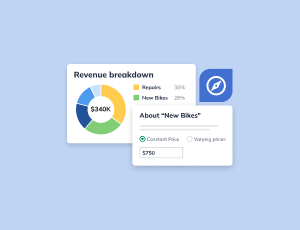
Free Download
Business Plan Template for Small Businesses
Business planning can feel complicated. It doesn't have to be. Start putting pen to paper today with your free business plan template download.
Download NowAvailable formats:
Downloads: 952,981
Our free template includes:
Detailed instructions
More than just a template of a business plan, you'll learn how to write a winning business plan.
SBA-lender approved format
Your plan is formatted the way lenders and investors expect.
Fill-in-the-blanks simplicity
You don't need to be an expert. This business plan template makes business planning easy.
Expert tips & tricks
Get expert guidance sent straight to your inbox!
All 100% free. We're here to help you succeed in business, no strings attached.










Why you need a business plan template
Writing a business plan can seem like a big task, especially if you’re starting a business for the first time and don’t have a financial background. After all, business plans have changed over the years, and what lenders and investors expect now is different than it was even just 10 years ago.
But using a business plan template will help you:
- Develop a strategy for success
- Reduce the risk of starting a business
- Explore new business ideas
- Attract investors and get funding
Learn more about how you can get value out of your business plan.
What is included in this free business plan template?
This template includes definitions, guidance, and examples for every business plan component needed to start, fund, and grow your business. Here are the sections covered in this template.
Executive summary
The brief summary of your business plan introduces everyone to your business, the problem you solve, and what you’re asking from your readers. It’s the first chapter of your business plan and the last thing you write once you have the details from your full plan.
- Company Purpose / Mission Statement: Briefly describe the business purpose or mission.
- Problem We Solve: Summarize the market need or problem addressed.
- Our Solution: Describe the product or service offered.
- Target Market: Identify the primary customer base.
- Team: Outline key team members.
- Financial Summary: Provide a brief overview of financial goals.
- *Optional Sections:
- Traction: Highlight initial sales or milestones.
- Funding Needed: Specify capital requirements if seeking funding.
Problem & solution
More than a simple description of your products and services – here you define the problem you’re solving and the value you provide. It’s also your chance to showcase any initial traction that shows you’re on the right track.
- Problem Worth Solving: Detailed description of the customer problem.
- Our Solution: Detailed description of the product or service.
- *Optional Sections:
- Traction: Evidence of market interest, such as sales or contracts.
- Intellectual Property/Patents: Outline any relevant IP or patents.
- Regulatory Requirements: Details on necessary government approvals.
- Future Products and Services: Potential future offerings.
Market analysis and target market
A detailed assessment of the market you intend to enter, including the size and value of the market, potential customer segments, and their buying patterns.
- Market Size & Segments: Define the size and characteristics of your target market.
- *Optional Sections:
- Market Trends: Consumer behavior and financial trends.
- Market Growth: Potential market size changes.
- Industry Analysis: Describe industry changes or trends.
- Key Customers: Identify any major customers.
- Future Markets: Potential market opportunities and strategy.
Competition
Show that you know who your competitors are, what advantages you have, and how you’re positioning your business to be competitive.
- Current Alternatives: Identify competitors in the market.
- Our Advantages: Describe strategic advantages over competitors.
- *Barriers to Entry (Optional): Discuss any barriers preventing new competition.
Marketing & sales
Describe how you’ll reach and sell to potential customers with a detailed sales plan and chosen marketing channels.
- Market Positioning: Define where your product or service fits in the market.
- Marketing Plan: Outline the strategy for reaching your target market.
- Sales Plan: Explain the sales strategy.
- *Optional Sections:
- Unique Value Proposition: What makes your offering unique.
- Pricing Strategy: Pricing compared to market alternatives.
- Distribution: How your product/service will reach customers.
- SWOT Analysis: Strengths, weaknesses, opportunities, and threats.
Operations
What makes your business run? Outline the day-to-day workflows and what needs to be set up for your business to deliver a product or service.
- Location & Facilities: Describe physical locations and facilities.
- Technology: Key technology crucial for the business.
- Equipment & Tools: Special equipment or tools required.
- *Optional Sections:
- Sourcing and Fulfillment: Description of sourcing and supply chain.
- Partners and Resources: Key partners and their contributions.
Milestones & metrics
Set goals for your business that include the dates and people responsible for accomplishing them. This is what you’ll use to manage responsibilities, track growth, and execute your larger strategy.
- Milestones: Specific goals and objectives with a timeline.
- Key Metrics: Performance indicators to gauge business health.
Company overview and team
Provide a brief rundown of the legal and structural components of your company, including your history, current team, and gaps you need to fill.
- Organizational Structure: Overview of the legal structure.
- Company History and Ownership: Brief history and ownership details.
- Management Team: Key team members and their qualifications.
- Management Team Gaps: Key positions needed for success.
Financial plan
Create well-structured and accurate financial statements to help you pitch to investors, land funding, and achieve long-term success. All without the help of a financial advisor or a degree in accounting.
- Projected Profit and Loss: Expected revenue, costs, and profitability.
- Projected Cash Flow: Cash inflows, outflows, and overall position.
- Projected Balance Sheet: Expected assets, liabilities, and equity balances.
- Use of Funds: Allocation of funds if raising capital.
- Exit Strategy: Plan for eventual business exit.
Appendix
While not required, this last section of your business plan is a great place to drop in additional documents that support and strengthen the rest of your plan.
How do you write a simple business plan?
If you’re exploring a business idea and don’t plan to pursue funding, then you actually don’t need to write a traditional business plan. Instead, opt for a one-page plan, which is far easier to create but just as effective.
To write a simple one-page business plan, follow the same core sections as a traditional plan. But instead of lengthy paragraphs and multiple pages covering each area of your business, stick with single sentences and bulleted lists.
If a one-page plan sounds like a better option, download our free simple one-page business plan template to get started.
Start your business plan today
Whether you're writing a business plan to validate your business idea, secure funding, or grow your existing business – our free business plan template will help you achieve your goals.
Download Now
Business plan template FAQ
Our free template is available to download in a number of common file formats including Google Docs, Microsoft Word (doc.x), or as a free business plan PDF.
This is a printable template—no matter if you download it as a pdf or word document, or access via Google Docs. The template is pre-formatted and structured to fit lender and investor standards, but can be edited and adjusted to suite your needs before printing. Just be aware that any changes may unintentionally break the template, so make sure to review before printing.
You should start with a good business plan template (like this one) to avoid having to make guesses about what to include in your business plan and how to structure the document. This template helps you organize your thoughts, and provides guidance, instructions, and examples to create an investor-ready and SBA-approved business plan format. It really speeds up the planning process. Oh, and it's 100% free!
You can absolutely write a business plan by yourself. Millions of entrepreneurs have been in your exact situation and have been able to write complete, detailed, and useful business plans. By using a template, you can speed up the writing process, avoid costly mistakes, and write your business plan without having to pay for additional support.
The steps to write a business plan include:
- Defining the opportunity: Explain the problem your business solves, the solution you offer, your target market, and the competitive landscape.
- Describing how you'll execute: Outline your marketing and sales strategies, operational plan, milestones, and success metrics.
- Adding company details: Provide information about your business structure, ownership, and team.
- Creating a financial plan and forecasts: Include detailed financial statements, forecasts, and funding requirements.
- Adding supplementary info to your appendix: Add any additional information, such as resumes, permits, and other relevant documents.
- Summarizing your plan: While it may be first, do your executive summary last. In it, you'll briefly summarize your business, highlighting key points such as mission, product/service, and basic financial information.
For additional information, check out our full step-by-step guide to write a business plan.
It can take as little as 30-minutes to write a fully functioning business plan. However, if you need to create a more detailed business plan it can take multiple hours to actually write the full document. To save yourself time, be sure to pick an appropriate plan type for your intended use case. Additionally, do any necessary research and collect your notes and other documentation beforehand so that you can focus all your effort on writing your business plan.
To write a simple business plan it's best to use a one-page business plan format. A one-page business plan includes all of the same components as a more detailed business plan but is designed to fit on a single page—making it more useful as an internal planning tool. If you still want to use a traditional business plan template, just focus on using bulleted lists and short sentences while writing to create a simpler business plan.
Writing a business plan can be easy if you use the right tools, understand your business, and come in prepared to write your business plan. Using a template can make writing a business plan easier. Additionally, if you focus on just getting your information down quickly, with the expectation that you'll revisit and revise your plan, you can speed up and simplify the process.
Yes, you can hire a professional business plan writer to write your business plan for you. Working with a professional can be especially useful if you're still struggling to write your business plan even when using a template for your business plan. Just be prepared to talk about your business, provide the appropriate details, and review the finished plan to be sure it actually reflects your business. If you need help vetting professional business plan writers, check out our free resource to help you ask just the right questions of potential plan writers.








